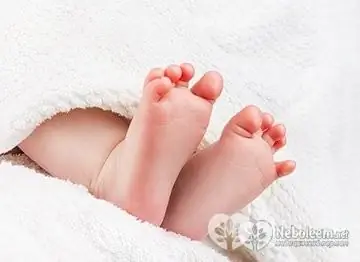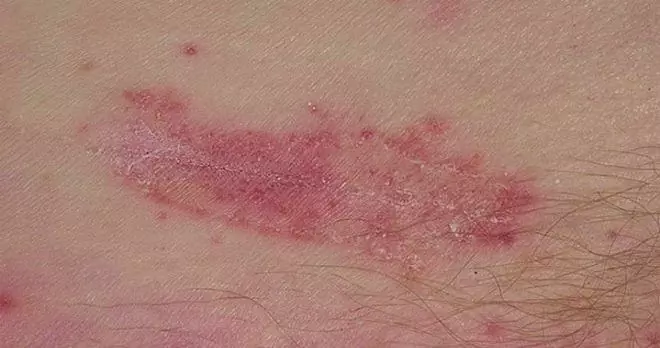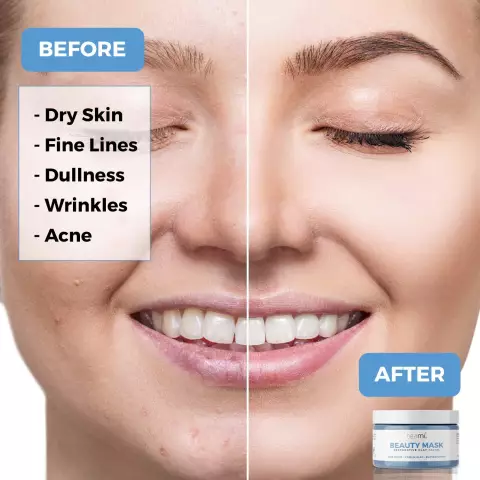- Author Rachel Wainwright [email protected].
- Public 2023-12-15 07:39.
- Last modified 2025-11-02 20:14.
Dry skin in a child

In the human body, the skin is one of the most important organs. It performs several functions at once: barrier, excretory, sensitive, thermoregulatory, storage and others. Therefore, parents should carefully monitor the condition of their baby's skin from early childhood.
Normally, the child's skin should be clean, smooth, free of cracks and inflammations. If there are any changes on it (redness or roughness), parents should immediately pay attention to this. The child's body signals that a failure has occurred in it.
If the child has dry skin, then its stratum corneum does not contain enough moisture. Its appearance changes - it becomes rough, wrinkled, sometimes even scaly, and loses its elasticity. But this is not the worst thing. The danger lies in the fact that microcracks appear in dry skin, through which pathogenic bacteria easily penetrate into deeper layers and cause the development of dermatological diseases.
Why does the baby have dry skin?
Dry skin in a child usually occurs in the first three years of life in the autumn-winter period or early spring. This phenomenon can be observed both on individual parts of the body (arms, legs, face) and on its entire surface. Children's skin is very sensitive to external factors, its protective function is only developing. Therefore, when dry spots or rashes appear on the body, it is important to determine which of the personal hygiene items can irritate the epidermis, and exclude shampoos, soaps, gels, washing powders to which the baby may be allergic. If the child has dry skin, you should only choose hypoallergenic products for hygiene and washing, preferably without a strong odor and bright color.
You should not bathe your baby in hot water, it tends to dry the skin, the optimal temperature for this procedure will be 37 ° C.
Sudden changes in temperature can also cause dry skin in a child. Severe frost and cold winds often cause irritation and redness on the face and hands. Therefore, before going outside, the baby needs to lubricate open areas of the body with a special cream.
Heating systems operating in winter dry out the air in apartments, therefore it is recommended to use special humidifiers during this period.
Dry skin in a child can be an allergic reaction of the body, so you should pay attention to food. These may include those that trigger allergies, such as citrus fruits and chocolate.
Dry skin of the feet of a child
Quite often, a child's dry skin is on the legs. Especially in the summer, it loses moisture to such an extent that it begins to crack and hurt. In this case, it is best to wear open shoes with maximum air access. To avoid dust and dirt getting into the cracks, you need to wear socks. Be sure to wash your baby's feet with baby soap before going to bed, wipe them dry and massage them with a special softening vitaminized cream.
Dry skin of the feet in a child is highly susceptible to infections, which can lead to complications. Everyone is familiar with prickly heat, diaper dermatitis, diaper rash with insufficient care spreads quickly, and even a pustular rash may form. To avoid complications, it is necessary to show the child to the doctor as soon as possible and begin treatment.
Treatment for dry skin in a child
The epidermis in young children is not yet able to retain sufficient moisture, so it has to be replenished from the outside. The choice of moisturizer must be taken seriously, as the skin reacts sharply to external stimuli. If the child has very dry skin, choose the remedy together with the pediatrician. Most often, in such cases, doctors recommend external preparations containing urea, in particular Excipial M lotion, as well as an additional course of vitamin A intake for a period of two months. It is better absorbed if you drop it on a small piece of brown bread before eating. In some cases, if the baby's skin is inflamed, vitamin E, calcium preparations, fish oil are prescribed. The dose of medication is determined by the doctor.
It is better to bathe a child without foaming detergents at all. Herbal baths are very effective in such cases. It is necessary to mix in equal proportions rose petals and chamomile flowers, pour boiling water and let it brew for 15-20 minutes. Then strain and add to water. The procedure should last at least 10 minutes. A flax oil bath is also effective (1 tablespoon will suffice).
After bathing, you can massage your baby by treating the skin with a cream containing vitamin A.
Dry skin of a child as a sign of the onset of the disease
Sometimes dry skin can indicate the onset of the development of a disease. Therefore, if redness or irritation occurs, parents need to consult a doctor in order to make an accurate diagnosis, establish the cause and begin treatment. Dry skin in a child, mainly under the age of 1 year, often occurs with atopic dermatitis. Severely itchy, reddened areas are localized on the face, without affecting the nasolabial triangle.
Peeling, scaly formations on the elbows, knees, cheeks can be signs of ichthyosis - a genetic disease in which the process of keratinization of cells is disrupted in the body.
If the child's skin is very dry and flaky, most likely it is hypovitaminosis A and PP, treatment in the form of taking the necessary vitamins eliminates the unpleasant symptoms.
It should be borne in mind that dry skin can be caused by dehydration of the body with dyspeptic disorders (vomiting, diarrhea) and heavy sweating.
Dry spots on baby's skin

Dry spots on the body of children appear often, and there is nothing unusual or scary in this, because she is very sensitive. But parents should be concerned if they do not pass for a long time. Firstly, the reason for such spots may be physiological, since the fat glands in small children are not yet fully functioning. Secondly, environmental factors (temperature and hardness of water, air humidity, food, soap) affect the condition of the skin. At first, to soften the affected areas, you can use a product purchased from a pharmacy, for example, Panthenol. But if dry spots on the child's skin do not disappear, you need to consult a doctor, as they can be symptoms of such serious diseases as atopic dermatitis, eczema, psoriasis.
Skin ailments are usually difficult to deal with, but a timely correct diagnosis makes the task easier. If there are already signs of a skin disease at an early age, it is very important to take immediate action and prevent its progression. Without proper treatment in a medical facility, it can become chronic.
YouTube video related to the article:
Found a mistake in the text? Select it and press Ctrl + Enter.






